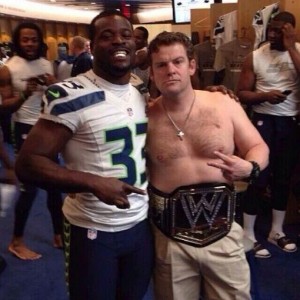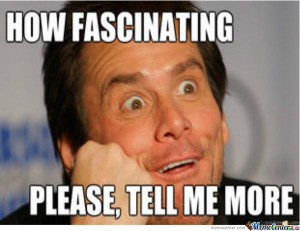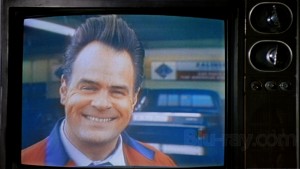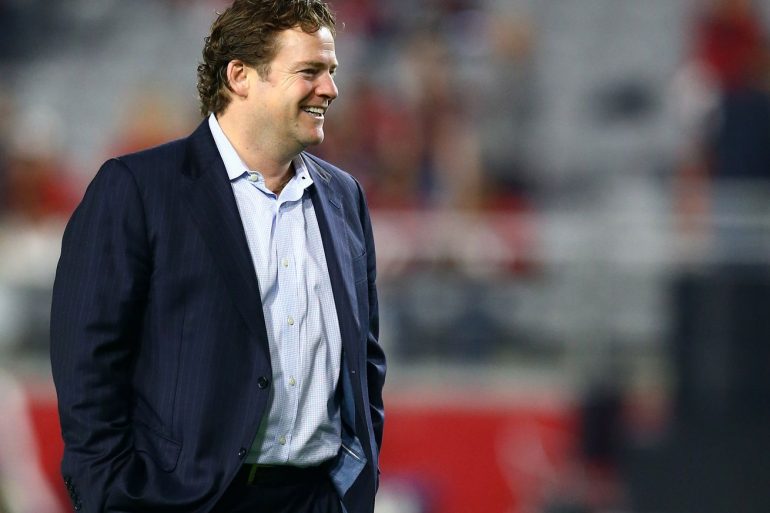Here Be Dragons! …and Seahawks
[dropcap size=big]W[/dropcap]e are living in unprecedented times of access and data that promise 12s the opportunity to not only ‘fan’ as hard as humanly possible, but to also relate to and understand the very inner workings of our NFL franchise. But with all heroes’ journeys to enlightenment and self-realization, the road is paved with danger and trolls. But mostly trolls, so if you prefer the status quo and the generally accepted Pablum followed by ads for Viagra and DraftKings, you may want to turn back now, because here be dragons!!!
Seattle has now enjoyed a consistent run of success in the NFL that has led to a greater demand than ever for everything Seahawks. 12s want to know what’s up and what’s next. A mature fan-base prides itself on being knowledgeable and involved at every level. Take a quick look at any social media timeline or attend a Bing Training Camp session, and you’ll see the magnifying glass being put on this team by 12s. We’ve moved beyond Monday Morning Quarterbacking. We demand 24/7/365 amateur GM status, and damn it, we’re not going to settle for anything less! Until our wives ring the dinner bell, I guess, then we’ll log off for a sec. But until that grisly, beer-soaked moment arrives, lets go HAM on this article. Go Hawks!
Spokes On A Wheel
Yes, I realize this piece is taking on a distinct Games of Thrones flavor now. Maybe it was the season premiere Sunday, or the wizard hat I enjoy wearing whilst I write, but hopefully you’ll find the analogy prescient. (No. Not, “precioussssss”, that’s the other one…)

There’s so much hype surrounding the NFL Draft these days it’s grown into an incredibly lucrative industry that carries us through what used to be the off-season. We’ve now recognized there is no off-season anymore, and in fact, I enjoy many elements of the NFL Draft as much, if not more, than many stretches of the regular season itself. I recall taking my Dad (an original season ticket holder from the expansion era) to watch preseason games, and he openly wondered why anyone would bother paying to see the young guys practice. What I sensed then is what interest in the NFL Draft now shows to be the new norm: We want to know these kids! We want to see the next generation coming and drink up the bro-cred that comes with spying the next super star in his formative years.
But in being caught-up in the excitement of scouting reports, Sr Bowl practices and Combine measurements, we begin to see these things as wholly separate events in the NFL calendar, each with it’s defined purpose and singular contribution to the futures of the franchises. This, of course, is simply how it is viewed through the lens of the fan. For NFL GMs, the Draft is just another spoke in the wheel of a greater machine that is Roster Building.
Winter Is Coming!
Yes, with the creeping inevitability of a pulp fiction horde, the end is growing nigh. The building suspense of the Salary Cap and its impact on successful rosters is devastating and, by design, the single driving force in achieving, maintaining or ending a Championship run in the NFL. Lucky, the Seahawks have their very own “John” Snow, who is still very much alive and ready to help 12s face the Stark reality of dynasty-building in the salary cap era. See what I did there? Ya, I know. Pretty bad right?
OK, so how does the Seahawks’ front office keep this party going and how does the NFL Draft fit in to the bigger picture? To understand a John Schneider draft, you must view it relation to other efforts being made to build the roster, as well as the opportunity costs associated with those moves. This’ where front office roles begin to be defined, but also where the terminology we use and the perceptions we have of the people within the VMAC begin to get confusing. While there’s been a fair amount written about Seahawks draft tendencies, positional values and team needs, what is lacking in the conversation is a clear definition of the motivations and strategies that tie them together as coherent tactics in a broader strategy, unique to John Schneider. This is the stuff of legend. Let’s explore!
Separating Myth from Math
As fans, we build-up our leaders into the heroes we need them to be. Believing that John Schneider possesses some secret knowledge that makes him special, makes us feel good and fortunate that he is ours, and not working for some other guys. Yet, we got him from the other guys to begin with. Schneids was taught what he knows and learned his lessons well. The cross-pollination of the Ted Thompson DNA in the NFL is unmistakable. It has common treads and its roots are buried deep in sound financial management and branding. These are top-down economics that start with committed ownership and continuity in the way you do business. College and pro scouting, free agency and the Draft are somewhere near the bottom of the list of things that make a winning organization, not near the top. This likely draws the most stark of contrasts between how fans view team building and how building a winning team actually happens.
*Fun fact: John Schneider is NOT a talent evaluator! He’s a talent appreciator. He does not make determinations about the quality of talent. He makes assessments of the ‘value’ of talent to his scheme and team relative to the marketplace, and what could be had as an alternative to slotting that player’s contract on his 53-man roster.
There are many examples of this axiom, ‘Management has greater value than Talent’, but the most obvious one is the AFC East where the Patriots have invited stars to walk while dominating the past 15 years of division play versus teams like Miami that try to make splashes early in free agency and pick high in the Draft every year. Bill Belichick is not a rock star. He’s not a magician. He’s a mathematician. And so is John Schneider.
Yes. I get it. I understand it’s frustrating to marginalize the “It” factor while rooting for your favorite team. We all want to be special in the ways that matter. It’s a flamboyant world and we all want to stand out. No one is sitting in their CPA’s accounting office lobby yelling, “Oh HELLS yes! Did you see him just TOTALLY limit risk while managing those cost cuts as a measure of GL spending? He seriously molly-whopped that investment strategy! BOOO-YA!”
But this is what it is. Building a team isn’t about watching tape, it’s about watching the bottom line. Not sexy, I know. Just don’t tell John that…

This is the hard part for fans because it would seem to make sense that you collect the best players available, pay them well and keep them as long as possible. If you have holes in the roster, there is no problem a few million dollars won’t solve. And if you need to cook the books to get there, go ahead and push those chips all-in because YOLO, right??? Wrong! The drunken brother of “Win Now” is “Perennial Loser.” This critical philosophy is worn like a badge of honor at the VMAC. You might recognize this as the Pete-centric moto, “Win Forever,” but it is this common ground, this bedrock that is shared between Pete and John that makes it a winning formula for the Seahawks. Pete puts polish, face and a top notch public relations machine out in front of it, but it lives in the dirty work of cost control and risk management which have become the hallmarks of a John Schneider team.
“I Got, I Got, I Got Whutchoo Need!”
So what is needed to build a winning team? As we approach the draft, it’s easy to identify what fans perceive to be holes in the roster, and we define these holes as “Team Needs.” Every industry guru, scout and would-be analyst start with this simple premise: You fill roster holes from the available talent pool, and you can prioritize these “needs” based on the current talent, or lack there-of, on the roster. Make sense? But while this makes for a fun exercise and some easily digestible groundwork for mock-drafters to ply their trade, unfortunately it just doesn’t happen that way in NFL front offices. It’s TOO easy. Too predictable and wholly 2-dimensional in the 3D world of the salary cap era.
So what DO you need as a NFL GM? Well, you certainly need to provide your coaching staff with the key cogs it requires to make their vision a reality on the field. You need to identify those players best suited to do that, and you need to be able to pay them for a long enough period of time to put it all together in a Championship run. Those are your only real needs. Note there is nothing player-specific here at all. It sounds almost heartless to emphasize that the individual players at the end of the equation are, 9 times out of 10, completely fungible. So for every 53-man roster, you’ve got about a half dozen difference-makers, the rest are average and replaceable soldiers. So your key goal is to not only find difference-makers for your team, but allocate your resources to acquire and retain those players in the positions that are most critical to the success of your coaching scheme. So you find the best players that can make the biggest difference, regardless of roster holes. This is utterly antithetical to using team need as a tool in prioritizing your draft and free agent acquisitions. This is the devil known as Positional-Value. It’s a necessary evil that inflates the importance of one talent pool above another and lays waste to mock-drafter and painstakingly-crafted draft grades buy the well-intentioned tape-watchers of our world.
This function of prioritizing causes fans and scouts endless heartburn as they watch players they feel can fill current holes passed-over for projects at other positions. Particularly when they hear John Schneider on the radio recently, admitting that need does push guys up their draft board. OK, but if team need is ignored by John until much later in free agency and the Draft, what the hell does he mean when he says that??? It’s a fundamental shift in defining what need is. When John says “need”, he is referring to the demands of the scheme which require added emphasis on position groups critical to success on the field. Naturally, he doesn’t want to tell you anything about his motivation or what they might suggest in predicting their personnel moves, but we can distill from that exactly what “need” means to John and Pete. It means needs of the scheme-dependent positions, not needs across all position. You see this reflected in the terms John and Pete use in speaking about adding and taking care of their “core guys.” But if this is accurate, it must also explain past moves, and beyond that, be predictive of future ones as well.
*Fun fact: Best Player Available is code for, “Piss off! I’m not telling you anything about my draft strategy!” BPA and team need inferences are simple smokescreens generally accepted among fans and pundits because they are easy to understand and tell you absolutely nothing about what is really going on. Like telling your 5 year-old that babies come from a stork, it’s just a pat on the head and a warm glass of milk at bedtime for the oblivious. Fans deserve better!

Hedges, Ledges and Trades, Oh MY!
Moving down through the tiers of talent evaluation and acquisition, it’s helpful to start plotting out what the scheme will demand of the roster in critical positions, then map out how much you want to spend on each one. There are many moving parts and the cap stretches over a series of years. Manipulating the salary cap is like a high-stakes game of gin rummy where the goal is to use your cards in combination all at the right time, marrying the cards in your hand to the cards on the table, leaving you with nothing left in your hand. But consider trying to do that while the King and the Jack decide they’d rather be paid like Aces, and the Queen and the 10 are considering retirement. Still want to be a NFL GM? Riiiiight…
For my money, the very best visualizations of this roster-building matrix, relative to contract slots over time, is done by Davis Hsu. His posts can be found on his Twitter TL @DavisHsuSeattle
So how do you get down to what’s really important? You rely on self-scouting as much as college scouting, but also plan contingencies that keep you young, cheap, and up-n-coming.
This is exactly why the offseason is so much fun. You get to see what the priorities really are in how teams spend their money. John and Pete approached free agency this year with the attitude of “OL problem? What OL problem?” Hilarious, I know. But I defy anyone to provide me a tangible example of where exactly the OL performance prevented the Seahawks from reaching their goals this year, and specifically in the game that ultimately sent them home versus Carolina. The answer is obvious. No matter how much you hate these kids and want them replaced, the OL was inconsequential in the final analysis. That is validated by the continued support they get unanimously from the GM and coaching staff, as well as the lack of prioritizing of this position group in free agency, and soon to be in the 2016 NFL Draft as well.
The example of Seahawks offensive line strategy illustrates a couple John Schneider strengths perfectly. A superior grasp of exactly what, and what is not, truly required for scheme success, as well as such expertly focused self-scouting that they can offer a project player like Garry Gilliam a promotion and actually sell it as an equivalent talent to almost any LT prospect in the Draft. By any measure, Gilliam is gifted and experienced enough to get this shot, and we’re sitting on the next giant John Schneider-Pete Carroll success story that they’ll claim they saw coming all along. Was Gilliam added to this team and groomed specifically for this moment? Maybe? Maybe not? But they must know his comparables athletically are all LT prospects and they looked into the future and knew it would be a hard sell to get Okung to return on a reduced deal, commensurate with his recent performance and reliability. Knowing Pete and John, I could totally buy that this was the plan for Gilliam, granted, in a best-case scenario, all along. Sure. This is what is known as a “Hedge.” It’s just one of the functions by which you make a perceived need, not a need.
Sure to become one of the most famous hedges in franchise history, is the selection of Tyler Lockett in 2015. As we’ve seen over and over again through the draft and free agency, vertical threats and playmakers across the field are viewed as a scheme-critical position in the Seahawks offense. Yet, the overall allocation of cap dollars to the offense must remain secondary to the spending on the defensive side of the ball. Percy, P-Rich, Jimmy, TDL are there to stretch you out and challenge you in space. But only one is needed to have this effect they are seeking in what is a deemphasized passing attack. A passing attack that unfortunately doesn’t have room for two guys getting paid to play the slot. I mean, everyone wants an All Pro kick returner, but that is secondary to staying young and cheap at the slot for years to come. Bad news for Doug Baldwin and he is all but being shown the door this offseason, as he’s received nothing more than a “we’ll see” after the Draft. That is not how you approach keeping a mission-critical veteran on your roster. They have never approached free agency with a guy they wanted to keep like that and it’s a sure sign he’s gone in 2016. They can afford to do this now because of the accession of Tyler Lockett. Between this and our previous Gilliam/Okung example, there is cap savings of approximately $15M APY between the vets and their would-be hedge replacements. That’s just good business. Few would be bold enough to claim they hedge their roster any better than John Schneider.
*Quick note on the perception of the Seahawks as a Run-First team: If you consider the “new money” portion of the Russell Wilson contract to be an addition starting with the 2016 cap, John Schneider & Pete Carroll will have paid MORE money to receiving targets over their first 5 years here than they have to QB’s and RBs COMBINED, AND have used early round Draft resources on selecting or acquiring (trade) receiving positions nearly 40% of the time! Who’s run-first? You could never tell by the way they spend their money and use draft capital, that’s for sure!

But what does all this mean for the draft!? It means there’s absolutely nothing to worry about. It means the Seahawks have a war room filled with sound decision-makers ready to attack the draft proactively because they know what is mission-critical and what is not, and have accumulated extra draft resources through wise planning and good calls in previous free agency periods to bring the maximum amount of leverage to their position. And this brings us to not only WHAT they will do in the Draft, but also, and as critically important, WHEN will they do it?
What we know: There is a lot that goes into planning draft strategy and we’re just scratching the surface here, but we know there is a hyper-focus on the Round 1. It makes and breaks drafts as well as the salary picture for your team for years to come. That’s why it’s so important to view the draft not as a place you plug holes (team needs), but a place in which you assure your financial cap health for the next generation. You want to assume success. That is precisely why QBs are so often over-drafted. Their positional value as a mission-critical piece of every scheme is just unrivaled in the sport. If your choice is Tom Brady or Von Miller, you take Brady every time, no exceptions. The 5th year options makes this a no-brainer for franchises seeking or hedging at the QB position. Core player free agency and franchise tags are a measure of failure on multiple levels, and the guy you want to ultimately keep as cheap as possible for as long as possible is the QB.
Every GM enters Day 1 of the Draft worried about how they are going to add a scheme-critical core player or a hedge at a scheme-critical position. Take Denver last year. They already have Demarcus Ware and Von Miller, and were ultimately on their way to a SuperBowl victory, as we now know. They had their hedge at QB sewn-up (so we thought!) in Brock Osweiler, as well as their DB’s under contract for a couple years to come. So, even though they did not possess any holes at DE/OLB, they chose to take a chance on a weed-smoking lightning bolt in Shane Ray out of Missouri. But why? They could have used a guy at some other position to help them right away, right? Ray hardly played at all last season, including the SuperBowl and playoffs, he made 12 appearances and totaled just 4 sacks. But what we see in the decision to go with Ray over another lesser player at a lesser scheme-value position for the Broncos is two-fold.
First, Ray dropped considerably on the news that he had failure drug tests prior to the draft. This made him a clearly better talent that the players around him on draft boards when it came time for Denver to pick. This is what is referred to as a talent “Ledge.” Or cliff or tier or many other terms to describe when the guy your looking at is almost as good as the other players at his position that were selected just prior, but after him there is no other prospects that compare to his talent or draftable grade.
Secondly, there were no more valuable positions to Denver’s offensive or defensive scheme that could take precedent away from Ray as a DE/OLB in a 3-4 alignment. Essentially, having an extra difference-maker in line to assume the role of an existing All Pro in the next 1 to 2 seasons was more important than say the best RT prospect available in the draft, which is where Denver went with their next selection in the 2nd Round taking Ty Sambrailo. Remember him? VMAC visitor and DraftTwitter mock hero? Ya, he stinks.
I love this example of Elway’s 2015 Broncos because it completely destroys the myth of “Win Now.” With a finished hero at QB and core scheme players facing free agency across the board, you could not possibly picture a franchise in more of a Win-Now scenario. Yet Elway not only hedged with Ray, he traded-up with Detroit to do it! Ledges and hedges exert so much gravity within the Draft, they drive the WHO as well as the WHEN. It was a brilliant trade that paid off immediate for them, and will continue to pay off for years to come. Elway is a BOSS. Win-now is the Kamikaze of the competitive world, and there’s no guarantee you even hit the mark.
So the draft is essentially where you stay young and cheap, maximizing club control of player contracts over the long term at key positions. Free agency is where you plug short-term holes by paying market values over the near-term that lack the essential element of club control. While it’s possible to find value in free agency, you can think of it as shopping Whole Foods versus Costco. With a limited grocery budget, you can impress your friends with a nice dinner this weekend, but by the end of the month you’ll be eating Top Ramen and pizza crusts again.
The final element where Free Agency and the Draft over-lap is in the Compensatory Pick formula. So when a high-profile player makes his money grab on the open market, you can get a player to replace him in the form of an additional future draft pick. GMs essentially trade top-of-the-market contracts and little club control, for volume in the draft, added service years and cheap club control of player contracts. It’s the money-laundering of the NFL. As if staying youngry and inexpensive weren’t reward enough, good GM’s like John Schneider, Bill Belichick, Ted Thompson and Ozzie Newsome play the Comp Pick game to maximum effect. There’s a reason you see these names associated with the majority of Lombardi Trophies presented over the past number of years. They are the current masters of the salary cap universe. Youth, volume, club control, cost control, service time, risk management. These are the lexicon of NFL success. You might throw luck in too. But, did anyone see the words “right tackle” or “3-technique” in there anywhere? No. No you did not.
Predictions For the 2016 NFL Draft and BEYOND!

My goal was to bring greater awareness for and clearly define the goals, strategies and tactics used by the most successful GMs in the NFL when building their rosters. Positional values, contract slotting, free agency and the draft are tools they use to accomplish this. They are not separate things. These are pieces to a larger puzzle and they can only be successful in coordination and in relation to one another. Addressing what we generally perceive to be team needs is a multi-faceted, multi-year project and there is no savior on the way that could effectively plug every hole in a roster. At best, roster building is a craps shoot and successful GMs hedge, stall and haggle at every opportunity to keep the whole thing affordable. They do this with limited resources, knowing there is no such thing as loyalty or home town discounts, and their fellow franchises lining-up to cut their throats at every turn. It’s a brutal marketplace for a brutal sport and it demands fresh blood constantly. That brings us to our Draft Predictions!
“Ave, Imperator, morituri te salutant!” – Better known in English as, “We, who are about to die, salute you!” This gladiator quote from classical literature is apropos knowing what we now know about the real toll on body and mind the NFL game demands of these kids we send to battle for our pride. Or, if that forces fans to look a little too deeply into their own blood-thirsty souls, feel free to substitute the following, “For those about to Rock, we salute you!” and let the repression begin.
Here’s a Round-by-Round projection based on positional-contract values, historical trends and college scouting in a John Schneider draft. *Taking off shirt, strapping-up WWE Championship belt* According to John and many professional scouts, identifying draft grades and strategy is a process of elimination, as much as anything else, when determining individual player choices. So I’ll follow that format below. Also, I’ve never been one to mock individual players because the vagaries of the draft make the chances of hitting on any player about equivalent to just blindly guessing. Mocking players serves no purpose beyond simple entertainment value, but I believe you can accurately mock positions by round. If you like having names in those spaces, try a fun mock generator like www.fanspeak.com and draw your own conclusions. It’s much more fun that other peoples’ guesses anyway. Enjoy!
RD1 – Pick #26 Scheme-critical core additions or hedges that could merit a 5th year option and a second contract would potentially include WR/DE/QB/RB/DB. Among those positions, the Seahawks have a future need to replace expiring contracts among WR/DE/RB/DB. Those positions that also project to have a talent ledge at or around #26 include WR and DB. But this scenario does not exist within a vacuum! There is precedent and gravity surrounding a trade-back to accommodate a QB-needy team moving back up into Round 1 from the early 2nd round. This makes all the sense in the world for the Seahawks. Teams looking to potentially grab the 2nd tier of QBs include Cleveland, NOLA, Chicago, SanDiego, Dallas, SF, Jets and Broncos. All may use their native 1st Rounders on scheme-dependent position players. Then again, they may all panic earlier than #26 and there will be no ledge left in a hopeless talent pool at QB.
Prediction: Seattle Seahawks get stuck with the #26 and select from among the last of the top DB prospects, addressing the RCB position, allowing Jeremy Lane to play in his natural slot-defender role, as Seattle plays in their nickel-package approximately 60% of the time. John knows well that Pete’s scheme requires THREE good DBs to allow Earl the freedom to be his All Pro-self, and to allow Kam to roam nearer the Line of Scrimmage. Don’t be fooled by them letting Byron Maxwell walk. He got a ridiculous contract. Even beyond what the Seahawks view as a mission-critical need. Early in free agency, they paid Cary Williams handsomely. RCB has positional value with the Seahawks that exceeds most other positions on the field, including OL and DT. Confidence in the RCB position was missing last season and it destroyed the scheme late in games as Earl was shaded to that side, pulling him out of position and leaving Kam exposed in coverage. Seahawks have a mission-critical need at RCB, despite the smokescreens you have heard from Pete recently, and John desperately needs to hedge not only the Brandon Browner signing, but also the very real chance Richard Sherman comes looking for more money next season, or walks in late free agency in 2 years. THIS is real need. This is the quintessential element that makes the way GMs view a draft fundamentally different from how fans view a draft.
“What the American public DOESN’T know, is what makes them the American public,” – Ray Zalinski, as portrayed by Dan Aykroyd in Tommy Boy, 1995.

Some possible names to consider within the DB talent pool available at #26 include William Jackson III, Mackenzie Alexander, Artie Burns, Keivarae Russell and TJ Green. I believe one of these players will be a Seahawk on Thursday or Friday night. Go Hawks!
RD2 – Pick #56 Having added what projects to be one of the next core players in Pete’s historically great defensive scheme, John will work down through the scheme and contract values list of priorities. At this point of the second round, you can expect the RB, WR and DE talent pools to probably look a lot like guys you’ll see available in Round 3, unless a player like Derrick Henry falls to them. But where you will begin to see a run on the final top prospects in this area will be OT and C. While these are not top scheme or contract-value priorities for the Seahawks, they may view Rd2 as their luxury pick, having previously noted the generationally deep talent pool of draftable players this year. The ledge at these positions is the perfect excuse to satiate the growing despair of the average #12 on the street, and they will take OL in some form here.
Some potential ledge names to consider include Joe Haeg, Joe Dahl, Max Tuerk and Nick Martin.
RD3 – Picks #90 and #97 We know that historically, Seahawks highly value skill positions early in drafts. If Derrick Henry is not yet on an NFL roster, he will be the pick at #90. If not, I believe they still recognize the ledge at the RB position and grab a compliment to Thomas Rawls here. We’ve seen the depth at DT push this positional-value lower that many expect already, but where do the Seahawks feel that ledge is? It may be around the bottom of the Top100. #97 could likely be a DT, and there is precedent there as Schneider also tapped the 3rd Round to select Jordan Hill. He will likely now use that same round to hedge him.
RB ledge here at Booker, Prosise, Ervin, and Dixon, but also don’t count out SPARQ-freak Lasco out of Cal. Here’s the Forrest Gump of this RB class behind Derrick Henry.
DL names include Hargraves, Ridgeway, and Henry
It’s nice to have two picks here in RD3, and knowing how important RB is to them (see Christine Michael), you could also flip-flop any picks from Rounds 2 and 3 here and it would still fit within the John Schneider-Pete Carroll universe.
RD4 -Pick #124 We’re really getting into the meat of this draft now and I believe this may be the last round to pull a bonafide starter out of this year’s draft class. The good news is, there are still plenty to be had in a historically talented group! Particularly if they passed up DL or OL in the 3rd to take advantage of droppers at RB or WR, you’ll see John go after an interior line position here.
Some names that can come in and compete right away include Joe Thuney, Rees Odhiambo and Willie Beavers across the OL, and Day, Reader, Collins, Fanaika, and Tapper across the DL. These are players that should get a real chance in camp to compete for playing time in the deep line rotations favored by Pete Carroll.
Beyond the 4th Round you’re looking at depth players and projects but a few names I like coupled with team interest or Seahawky measureables for the 5th, 6th and 7th rounds include:
WRs – Daniel Braverman and Moritz Boehringer
DBs – Sean Davis, Blake Countess and Daryl Worley
TE – Terren Houk
RBs – Alex Collins and Kenyan Drake
QBs – Kevin Hogan and Vernon Adams
OLB/DE – ????
By far, the most mystery for the Seahawks in the 2016 NFL Draft revolves around how they rate and plan to address a replacement for Bruce Irvin at SAM. My guess is that it’s because Bruce wasn’t only a SAM. He was also a nickel package rusher, which we know is essentially the base package here in Seattle. So that begs the question: Will Irvin’s replacement be a DE prospect, or a more traditional OLB? Bruce was rare. He could do it all. Maybe not as well as we had hoped, and this is what made him expendable, but many believe you don’t just replace him with one guy.
While there is some weight to the thought that Clark, Marsh and Morgan will hold down a combination of sub-package and base duties vacated by the departing former 1st round pick, my Spidey-sense is tingling off the charts here. In reviewing the group of players that received VMAC visits or private workouts this spring, there is a distinct negative space in the middle of the DE/OLB position grouping. The only players brought in are potential 1st round picks and the same guys everybody brought in for that matter. The VMAC visits on DL & OLB tell us absolutely nothing about the intentions John has for replacing Bruce. The smokescreen is in place. The scheme-critical need is clear and their looks to be an open contract value slot for that DE position in the not too distant future. The precedent is there for taking that player in the 1st round. Could EDGE be in the mix for Seahawks? Maybe. I don’t think it outweighs the gravity around CB, but it’s impossible to say how the Draft will fall. I think there’s two great scenarios there for the 1st round and, in the long run, #12s are going to be thrilled with this draft haul, in any event. Enjoy Thursday night! But have a hedge party planned for Friday in case they trade out, too… Go Hawks!
For more info, feedback and live-blogging of the 2016 NFL Draft draft, follow me on Twitter at @hawksdraftnews.
